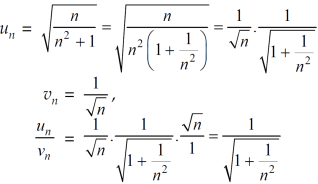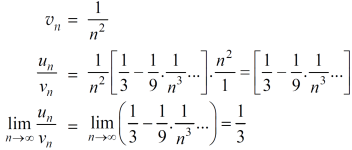Question Bank
UNIT–3
Sequence and series
Question-1: If  , then the limit of
, then the limit of  will be,
will be,
 =
=  =
=  = ½
= ½
Hence the limit of the sequence is 1/2 .
Question-2: check whether the series  is convergent or divergent. Find its value in case of convergent.
is convergent or divergent. Find its value in case of convergent.
Sol. As we know that,
Sn = 
Therefore,
Sn = 
Now find out the limit of the sequence,
 = ∞
= ∞
Here the value of the limit is infinity, so that the series is divergent as sequence diverges.
Question-3: check whether the following series is convergent or divergent. If convergent , find its value.

Sol. n’th term of the series will be,



 ] = ½
] = ½
Question-4: Test the convergence of the series whose nth term is given below-

Sol.


By root test  is convergent.
is convergent.
Question-5: Test the convergence of the following series:

Sol. Here, we have,




Therefore the given series is convergent.
Question-6: Test the convergence of the series whose n’th term is given below-
n’th term = 
Sol. We have  and
and 
By D’Alembert ratio test,

So that by D’Alembert ratio test , the series will be convergent.
Question-7: Test for the convergence of the n’th term of the series given below-

Sol. We have ,



Now , by D’Almbert ratio test  converges if
converges if  and diverges if
and diverges if 
At x = 1 , this test fails.
Now , when x = 1


The limit is finite and not zero.
Then by comparison test,  converges or diverges together.
converges or diverges together.
Since  is the form of
is the form of  , in which
, in which 
Hence  diverges then
diverges then  will also diverge.
will also diverge.
Therefore in the given series  converges if x<1 and diverges if x≥1
converges if x<1 and diverges if x≥1
Question-8: Test the convergence of the given series:

Sol. Here,

Take,

 is divergent by p-series test. (p = 0 <1)
is divergent by p-series test. (p = 0 <1)
Question-9: Test the convergence of the following series.

Sol. We have 
First we will find  and the
and the 


And

Here, we can see that, the limit is finite and not zero,
Therefore,  and
and  converges or diverges together.
converges or diverges together.
Since  is of the form
is of the form  where p = 2>1
where p = 2>1
So that , we can say that,
 is convergent , so that
is convergent , so that  will also be convergent.
will also be convergent.
Questtion-10: Test the convergence of the following alternating series:

Sol. Here in the series, we have


First condition-


So that,
| | > |
| > | |
|
That means , each term is not numerically less than its preceeding terms.
Now second condition-

Both conditions are not satisfied for convergence.
Hence the given series is not convergent. It is oscillatory.
Question-11: If the series  converges, then find the value of x.
converges, then find the value of x.
Sol. Here 
Then,


By D’Almbert’s ratio test the series is convergent for |x|<1 and divergent if |x|>1.
So at x = 1
The series becomes- 
At x = -1

This is an alternately convergent series.
This is also convergent series, p = 2
Here, the interval of convergence is 
Question-12: Express the polynomial  in powers of (x-2).
in powers of (x-2).
Sol. Here we have,
f(x) = 
Differentiating the function w.r.t.x-
f’(x) = 
f’’(x) = 12x + 14
f’’’(x) = 12
f’’’’(x)=0
Now using Taylor’s theorem-
 + ……. (1)
+ ……. (1)
Here we have, a = 2,
Put x = 2 in the derivatives of f(x), we get-
f(2) = 
f’(2) = 
f’’(2) = 12(2)+14 = 38
f’’’(2) = 12 and f’’’’(2) = 0
Now put a = 2 and substitute the above values in equation(1), we get-



Question-13: Find the Taylor’s expansion of  about (1 , 1) up to second degree term.
about (1 , 1) up to second degree term.
Sol. We have,

At (1 , 1)
















Now by using Taylor’s theorem-
 ……
……
Suppose 1 + h = x then h = x – 1
1 + k = y then k = y - 1
 ……
……
 =
= 
 ……..
……..
Question-14: Find the value of 5 , correct to five decimal places by using the power series for
, correct to five decimal places by using the power series for  .
.
Sol. As we know that the exponential series is-






Here we get-

Now

Question-15: Simplify 
Sol. We know that-

So that

